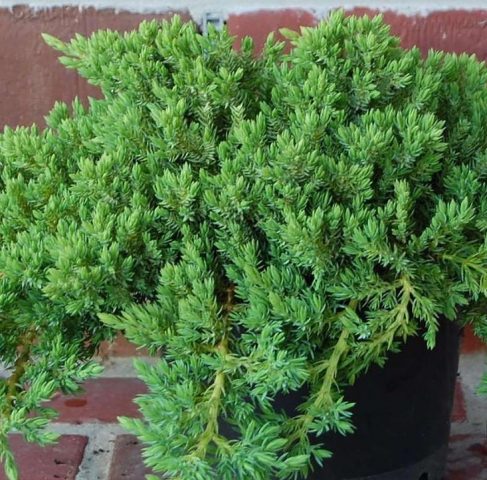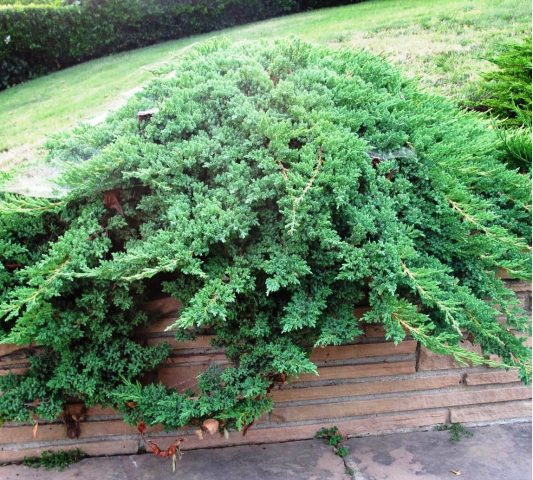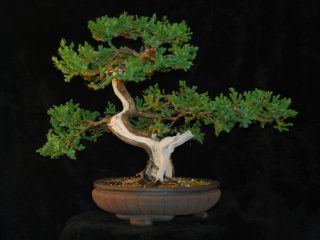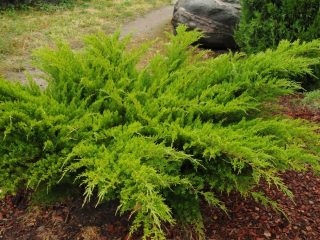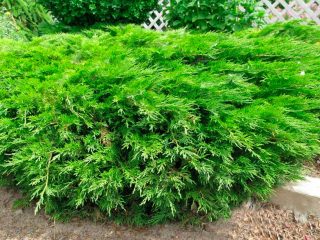Content
The recumbent juniper Nana is a variety that compares favorably with other varieties with its compact size. The short stature makes it easier to care for the shrub, and also allows you to use it for creating borders, decorating tall crops and small flower beds. This species has gained great popularity for its unpretentiousness and resistance to typical diseases of conifers.
Description of the juniper recumbent Nana
The recumbent juniper Nana (juniperus procumbens nana) is a dwarf creeping shrub, the height of which does not exceed 40 cm. The bush grows 130-150 cm wide. The needles of this variety are soft, small. Its color ranges from bluish-silvery to greenish-blue tones.
Like many juniper varieties, Nana is a long-lived plant with a slow growth rate. The annual growth of the shrub is only 30 cm, due to which the plant retains its shape for a long time after pruning. This quality is highly valued in landscape design, because the juniper can do without crown formation for long periods of time.
A distinctive feature of the Nana variety is its immunity to low temperatures, which makes it possible to grow shrubs in most of Russia, including in the northern regions. In addition, the plant tolerates prolonged drought well.
Juniper Nana recumbent in landscape design
As you can see in the photo below, Nana recumbent juniper is often used to decorate city parks and playgrounds. This is because the variety is fairly resistant to air pollution.
Most often, Nana juniper is grown as follows:
- as a ground cover crop for decorating slopes;
- as part of rock gardens;
- for landing on roofs and balconies;
- as part of coniferous groups together with spruce, pine, thuja, etc.;
- for registration of undersized borders;
- in the form of homogeneous compositions;
- for placement on terraces in containers;
- as a decoration in rocky gardens.
Planting and caring for juniper recumbent Nana
Planting and caring for the recumbent Nana variety is not particularly difficult. The plant is quite unpretentious and does not impose serious requirements on the type of soil. On the other hand, in order to fully reveal the potential of this variety, it is recommended to adhere to some general rules when choosing a site for planting a plant:
- Juniper variety Nana grows best in acidic, well-drained soils.
- This species grows poorly in a lack of light, so it should be planted in open sunny areas.
- The growth of a shrub can be inhibited by planting in a lowland - with this arrangement, there is a high probability that moisture will stagnate in the ground after heavy rains. An increased level of soil moisture often provokes root rot in junipers.
Seedling and planting plot preparation
Despite the fact that the Nana recumbent juniper takes root well on almost all types of soil, sometimes it is better to slightly correct the area before planting the plant. If the soil on the garden plot is clayey and heavy, you can dilute it with a sand mixture. For this, fine-grained sand, sod land and peat are mixed in equal proportions.
Landing rules
Seedlings with open roots are planted in spring or autumn. If spring is selected, planting can be done immediately after the snow melts. The earlier the shrub is planted, the better. Seedlings with closed roots are also planted in spring, autumn, even winter is suitable.
The planting procedure for Nana juniper is as follows:
- For a group landing, the landing pits are placed at a distance of 90-100 cm from each other. The diameter of the pit is 70-80 cm, the depth is 60-70.
- A drainage about 10 cm thick and a fertile soil mixture of sand, turf and peat, taken in a ratio of 1: 1: 2, are placed on the bottom of the pit.
- After that, the seedling is lowered into the pit, gently spreading its root system.
- The roots of the juniper are sprinkled with earth and lightly tamped.
- Then the bush is watered abundantly.
If desired, Nana Juniper can be sprinkled with a mulch layer. Sawdust, peat, dry grass and leaves, as well as wood chips are used as mulch.
Watering and feeding
Juniper variety Nana tolerates drought well, so it does not need frequent watering. It is recommended to water adult plants no more than once a month. In conditions of prolonged rains, watering is completely stopped.
Despite the fact that the Nana juniper grows well without additional fertilizing, if desired, you can add nitrophoska or special mixtures for conifers to the soil. Plants are usually fertilized in spring.
Mulching and loosening
Loosening of the soil in the area of the trunk circle is necessary in order to ensure better air flow to the root system of the shrub. At the same time, it is not recommended to loosen the soil too deeply, because in this case, the thin roots can be damaged.
Mulching your Nana Juniper is optional, but it does a better job of retaining moisture in the soil. In addition, the mulching layer protects the juniper from hypothermia in winter. In summer, mulch inhibits the growth of weeds.
Trimming and shaping
Juniper Nana is cut no more than 2 times a year. The procedure is carried out in the last days of April and July. At the same time, all dry, damaged and diseased branches are first cut off, after which they begin to form the crown. The variety is cut from the bottom up.
Preparing for winter
The description for the Nana juniper indicates that the plant tolerates low temperatures well, so adult plants do not need additional shelter for the winter. Only young bushes up to 2-3 years old are insulated in the fall. To do this, use a garden fabric that allows air to pass through well. The trunk circle is sprinkled with spruce branches.
Reproduction of Procumbens Nana juniper
Procumbens Nana juniper is propagated by cuttings or layering, but the first method is preferable. Cuttings are harvested at any time of the year, but it is best to cut the bushes in the spring months - so young bushes can survive the winter in the open field without any complications. their root system will have time to strengthen before the onset of the first frost.Cuttings cut in August must be moved indoors, otherwise they will freeze in winter.
The procurement procedure is as follows:
- Juniper Nana is a creeping species, therefore, any branches are selected as planting material, except for those that grow vertically.
- The selected branches are carefully cut with a sharpened knife or garden shears. A blunt instrument leaves behind ragged cuts that take a long time to heal and greatly weaken the bush. Before starting cutting, the blades must be disinfected with a weak solution of potassium permanganate.
- Cuttings are cut together with the "heel" - a piece with old wood, which is located at the point where the branch is attached to the main shoot.
- The resulting planting material is cleaned from below, removing needles from the surface of the shoots by 4-5 cm. This is necessary for better development of the root system of future bushes.
- You cannot postpone transplanting cuttings. Cut shoots must be planted in open ground on the same day, no more than 3 hours later. It is advisable to do this as quickly as possible, in extreme cases, you can lower the planting material into water for 1-2 hours.
- Plants are planted in loose, permeable soil. Juniper variety Nana develops best on soils with a high level of acidity, therefore, before planting, you cannot fertilize the site with wood ash or eggshells.
Reproduction of Nana juniper with layering is not so widespread, but the procedure is quite simple. In order to form a layering, it is necessary to bend the young shoot to the ground and slightly dig in it. In this case, it is important to fix it so that it does not unbend. When the cutter forms a full-fledged root system, it can be finally separated from the mother bush and transplanted.
Diseases and pests of horizontal Nana juniper
The recumbent juniper of the Nana variety practically does not attract insects. Occasionally, bushes can infect aphids, moths or sawflies, but any insecticide can easily deal with these pests.
The variety is also extremely rare. Outbreaks of diseases occur mainly with gross violations of agricultural practices or during prolonged rains, when the air humidity rises sharply. Under such conditions, a fungus is actively developing, which causes the rapid death of the juniper bark and provokes the development of rot. In order to get rid of fungal infections, the bushes are sprayed with Bordeaux liquid or copper sulfate.
Conclusion
Even a novice gardener can grow a recumbent juniper Nana - this is one of the most unpretentious coniferous crops, capable of developing well even with minimal care. Compact forms, attractive appearance and undemanding shrubs have won him great popularity, but the list of its advantages does not end there. If you wish, you can independently squeeze aromatic essential oil from the shoots of Nana juniper, which has a lot of useful properties.
